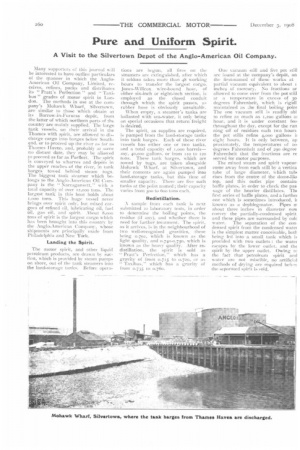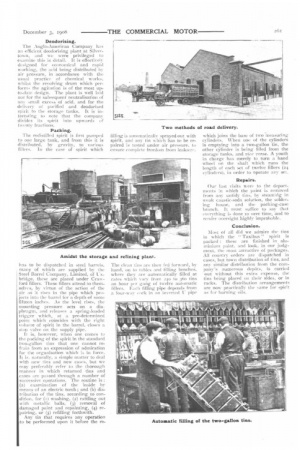Pure and Uniform Spirit.
Page 16

Page 17

If you've noticed an error in this article please click here to report it so we can fix it.
A Visit to the Silvertown Depot of the Anglo-American Oil Company.
Many supperturs of this journal will be interested to have outline particulars ol the manner in which the AngloAmerican Oil Company, Limited, receives, refines, packs and distributes its " Pratt's Perfection " and " Taxibus " grades of motor spirit in London. The methods in use at the company's Mohawk Wharf, Silvertown, are similar to those which obtain at its Barrow-in-Furness depot, from the latter of which northern parts of the country are mainly supplied. The large tank vessels, on their arrival in the Thames with spirit, are allowed to discharge cargo into barges below Southend, or to proceed up the river as far as Thames Ilaven, and, probably at some no distant date, they may be allowed to proceed as far as Purfket. The spirit is conveyed to wharves and depOts in the upper reaches of the river, in tank barges towed behind steam tugs. The biggest tank steamer which belongs to the Anglo-American Oil Company is the " Narragansett," with a total capacity of over 12,000 tons. The largest tank in this boat holds about t,00n tons. This huge vessel never brings over spirit only, but mixed cargoes of refined oil, lubricating oil, fuel oil, gas oil, and spirit. About 8,000 tons of spirit is the largest cargo which has been brought into this country by the Anglo-American Company, whose shipments are principally made from Philadelphia and New York.
Landing the Spirit.
The motor spirit, and other liquid petroleum products, are drawn by suction, which is provided by steam pumps on shore, out of the tank steamers into the land-storage tanks. Before opera
tions are begun, all tires on the steamers arc extinguished, after which it seldom take, more than 48 working hours to transfer the largest cargo. Jones-Willcox wire-bound hose, of either six-inch or eight-inch section, is employed as the closed conduit through which the spirit passes, as rubber hose is obviously unsuitable.
kl'hen empty, a steamer's tanks are ballasted with sea-water, it only being on special occasions that return freight is desired.
The spirit, as supplies are required, is pumped from the land-storage tanks into tank barges. Each of these river vessels has either one or two tanks, and a total capacity of 1,000 barrels— say, 40,000 gallons. or from Ito to 120 tons. These tank barges, which are towed by tugs, are taken alongside Mohawk Wharf, at Silvertown, and their contents are again pumped into land-storage tanks, but this time of smaller capacity. There are live such tanks at the point named; their capacity varies from 500 to 600 tons each.
Redistillation.
A sample from each tank is next submitted to laboratory tests, in order to determine the boiling points, the residue if any), and whether there is need for further .treatment. The spirit, as it arrives, is in the neighbourhood of two well-recognised gravities, these being 0.702, which is known as the light quality, and 0.740-0.750, which is known as the heavy quality. After redistillation, the spirit is sold as " Pratt's Per fection, '' which has a gravity of from 0.715 to 0.720, or 4Is " Taxibus," which has a gravity of from 0.735 10 0.760. One vacuum still and live pot still are found at the company's depot, an the tirst-named of these works at partial vacuum equivalent to about inches of mercury. No fractions ar allowed to come over from the pot still at a temperature in excess of 30 degrees Fahrenheit, which is rigidi
maintained as he final boiling point The one vacuum still is readily abl to refine as much as 1,200 gallons a: hour, and it is under constant feel throughout the day, except for the run fling off of residues each two hours
the pot stills refine 4,000 gallons ii eight hours. It is only between, ap
proximately, the temperatures of to degrees Fahrenheit and of 290 degree Fahrenheit that the fractions are re served for motor purposes. The mixed steam and spirit vapour: come away from each still by a vertica tube of large diameter, which tubi rises from the centre of the dome-likr top, and this outlet pipe contain: baffle plates, in order to check the pas sage of the heavier distillates. Th< first series of baffle plates, and a furthei one which is sometimes introduced, it known as a depblegmator. Pipes ct about three inches in diameter no convey the partially-condensed spirit and these pipes are surrounded by cole water. The separation of the con.
den sed spirit from the condensed watet
is the simplest matter conceivable, bott, being led into a small tank which is
provided with two outlets : the watet escapes by the lower outlet, and the spirit by the upper outlet. Owing tc the fact that petroleum spirit and water are not miscible, no artificial methods of drying are required before the separated spirit is sold. Deodorising.
The Anglo-American Company has an efficient deodorising plant at Silvertown, and we were privileged to examine this in detail. It is effectively designed for economical and rapid working, the acid being distributed by air pressure, in accordance with the usual practice of chemical works, whilst the revolving drum which performs the agitation is of the most upto-date design. The plant is well laid out for the subsequent neutralisation of any small excess of acid, and for the delivery of purified and deodorised spirit to the storage tanks. It is interesting to note that the company divides its spirit into upwards of twenty fractions.
Packing.
The redistilled spirit is first pumped to one large tank, and from this it is distributed, by gravity, to various fillers. In the case of spirit which
has to be dispatched in steel barrels, many of which are supplied by the Steel Barrel Company, Limited, of Uxbridge, these are placed under Crawford fillers. These fillers attend to themselves, by virtue of the action of the air :is it rises in the pipe which projects into the barrel for a depth of some fifteen inches. As the level rises, the mounting pressure acts on a diaphragm, and releases a spring-loaded trigger which, at a pre-determined point which coincides with the right volume of spirit in the barrel, closes a stop valve on the supply pipe.
It is, however, when one comes to the packing of the spirit in the standard two-gallon tins that one cannot refrain from an expression of admiration for the organisation which is in force. It is, naturally, a simple matter to deal with new tins and new cases, but we may preferably refer to the thorough manner in which returned tins and cases are passed through a number of successive operations. The routine is : (a) examination of the inside by means of an electric torch; and (b) distribution of the tins, according to condition, for (i) washing, (2) rattling out with metallic balls, (3) removal of damaged paint and repainting, (4) repairing, or (s) refilling forthwith.
Any tin that requires any operation to be performed upon it before the re
filling is automatically sprayed out with spirit, and any tin which has to be repaired is tested under air pressure, to ensure complete freedom from leakavv.
The clean tins are then fed forward, by hand, on to tables and filling benches, where they are automatically filled at rates which vary from 240 to 36o tins an hour por gang of twelve automatic fillers. Each filling pipe depends from a four-way cock in an inverted U pipe which joins the base of two measuring cylinders. When one of the cylinders is emptying into a two-gallon tin, the other cylinder is being filled from the storage tanks, and vice versa. A youth in charge has merely to turn a hand wheel on the shaft which runs the length of each set of twelve fillers (24 cylinders), in order to operate any set.
Repairs.
Our last visits were to the departments in which the paint is removed from any untidy tins, by steaming in weal; caustic-soda solution, the soldering house, and the packing-case branch. It must suffice to say that everything is done to save time, and to render oversight highly improbable.
Conclusion.
Most of all did we admire the tins in which the " Taxibus " spirit is packed : these are finished in aluminium paint, and look, in our judgment, the most attractive of packages. Al! country orders are dispatched in cases, but town distribution of tins, and any similar distribution from the company's numerous depots, is carried ' out without this extra expense, the tins being placed on their sides, or in racks. The distribution arrangements are now practically the same for spirit as for burning oils.
























